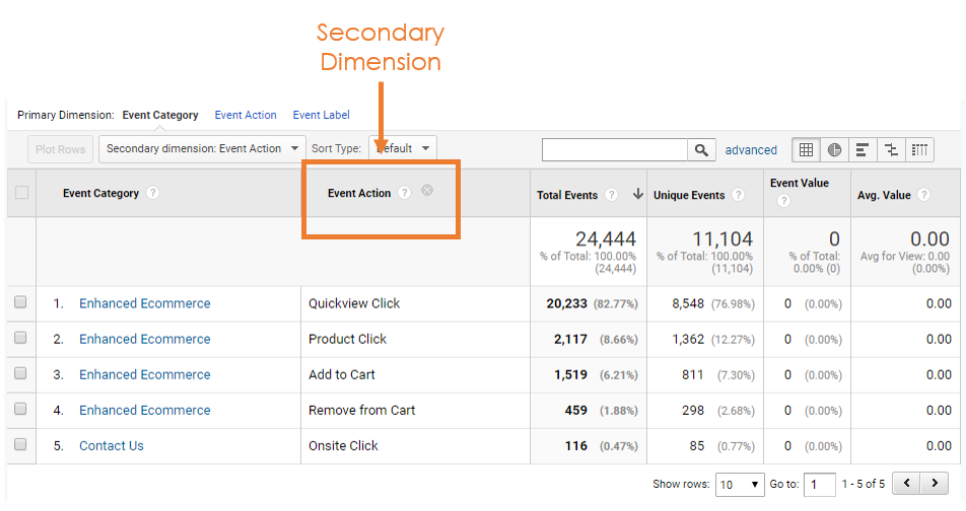What Is Secondary Dimension in Google Analytics: Tips and Best Practices
What Is Secondary Dimension in Google Analytics: Tips and Best Practices
Blog Article
Maximizing Your SEO Technique With Google Analytics: Checking Out the Second Dimension
In the world of electronic advertising, the quest of refining Browse Engine Optimization (SEO) strategies to attain optimum results is a continuous venture. By diving into this even more nuanced dimension, marketing experts can uncover concealed patterns, recognize untapped potential, and eventually propel their SEO campaigns to new heights.
Data-Driven Search Engine Optimization Insights
Utilizing information analytics to inform and improve search engine optimization methods is crucial for accomplishing ideal on-line visibility and performance. Data-driven SEO insights give beneficial information that can direct decision-making processes and boost the performance of digital advertising initiatives. By assessing information collected through tools like Google Analytics, search engine optimization specialists can gain a deeper understanding of user habits, choices, and patterns. This info assists in recognizing pertinent key phrases, maximizing website content, and refining general search engine optimization approaches to better align with the requirements of target market.
One key benefit of leveraging information analytics in Search engine optimization is the capacity to gauge the efficiency and track of different optimization methods. In verdict, integrating data analytics right into SEO techniques is necessary for staying in advance in the digital marketing video game and optimizing online exposure and success.
Studying Customer Habits Patterns
By checking out user actions patterns, search engine optimization professionals can gain useful insights right into exactly how target markets communicate with online web content, structure upon the data-driven SEO understandings formerly reviewed to improve optimization methods even more. Examining individual behavior patterns involves tracking metrics such as bounce rate, time on web page, web pages per session, and conversion rates. These metrics supply an extensive view of exactly how individuals involve with an internet site, highlighting locations for improvement and optimization. A high bounce price might show that the landing web page web content is not appropriate to visitors, prompting the need for content modifications. Comprehending individual habits patterns can likewise assist in identifying popular key phrases, chosen material layouts, and optimal posting times, enabling SEO professionals to tailor their methods to much better satisfy target market preferences. By leveraging devices like Google Analytics to track and assess customer actions, search engine optimization specialists can make data-driven choices that improve web site efficiency and drive natural web traffic growth.
Enhancing Material Performance Metrics
Assessing content efficiency metrics offers valuable understandings into the performance of on the internet materials in involving audiences and driving wanted outcomes. By delving right into metrics such as page views, bounce prices, time on web page, and conversion rates, businesses can get an extensive understanding of exactly how their web content resonates with customers. Google Analytics offers a riches of devices to enhance material efficiency monitoring, enabling for the dimension of vital efficiency signs (KPIs) that align with certain organization goals.
One crucial element of optimizing material performance is identifying high-performing content and leveraging insights acquired from such analysis to inform future material development approaches. By pinpointing the kind of material that draws in and maintains individuals, services can customize their material techniques to better meet target market choices and assumptions. Furthermore, tracking metrics connected to user engagement can help recognize locations for enhancement, enabling businesses to improve their web content to improve individual interaction and conversions. In essence, enhancing material performance metrics through Google Analytics encourages organizations to improve their electronic techniques for maximum impact - what is secondary check my source dimension in google analytics.

Optimizing Conversion Funnel Evaluation
Enhancing the performance of conversion channel evaluation is crucial to boosting electronic advertising and marketing efficiency and maximizing ROI. By optimizing the conversion funnel analysis, companies can acquire important insights into client behavior at each stage of the buying journey. Google Analytics provides a durable system for tracking and evaluating user interactions, permitting marketing experts to recognize prospective traffic jams and areas for improvement within the conversion procedure.
To enhance conversion funnel evaluation properly, it is important to establish pertinent goals and track essential performance indicators (KPIs) that straighten with company objectives. By specifying clear goals for each phase of the channel - from understanding to conversion - marketing professionals can much better comprehend where users are handing over and make data-driven choices to enhance the total individual experience.
Additionally, conducting A/B screening and multivariate testing can help improve conversion funnel strategies by contrasting various variations of touchdown web pages, forms, or calls-to-action. By continually optimizing the conversion and keeping an eye on channel, organizations can boost conversion rates, drive even more competent leads, and ultimately increase revenue.
Applying Actionable Search Engine Optimization Methods
To take full advantage of the effect of conversion funnel evaluation and drive organic traffic growth, companies index should strategically implement workable SEO techniques. Executing workable Search engine optimization methods involves a multifaceted strategy that starts with detailed keyword research study.

Final Thought

By taking a look at individual habits patterns, Search engine optimization specialists can obtain beneficial understandings right into how audiences interact with online content, structure upon the data-driven SEO understandings previously discussed to refine optimization approaches further. Understanding user behavior patterns can also help in identifying popular key words, chosen content layouts, and optimum publishing times, allowing SEO experts to tailor their techniques to better fulfill target market choices.To make best use of the effect of conversion funnel evaluation and drive natural web traffic growth, businesses have to tactically execute actionable Search engine optimization methods. By integrating these workable SEO strategies right into their digital marketing initiatives, services can improve their on-line existence, attract even more natural web traffic, and ultimately drive conversions.
In verdict, using Google Analytics to optimize your Search engine optimization strategy can give useful data-driven insights right into user behavior patterns, content performance metrics, and conversion channel analysis.
Report this page